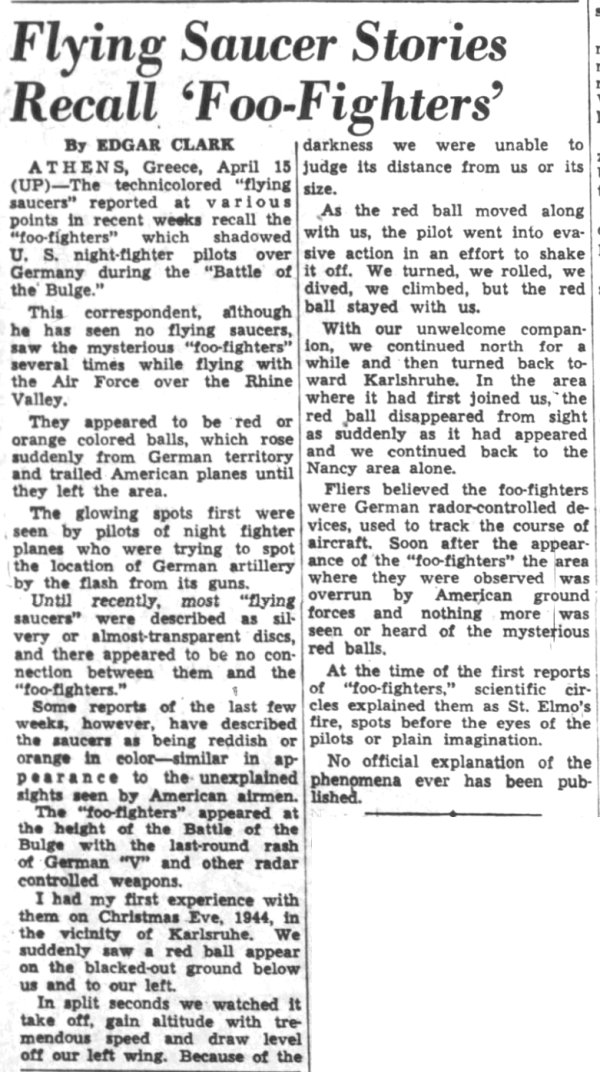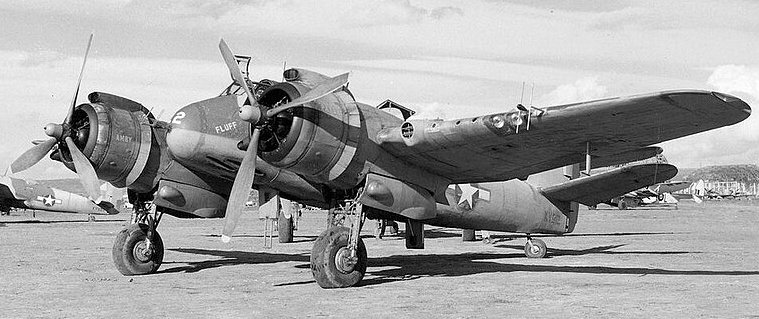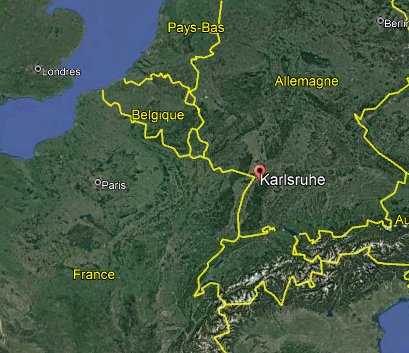ACUFO-1944-12-24-KARLSRUHE-1
Sergeant Edgar Clark, press correspondent, in December 1944, was in Europe and had participated in the night missions of the Bristol Beaufighters of the 415th Night Fighter Squadron over the Rhine valley, still enemy territory. He subsequently wrote an article published in the Stars and Stripes magazine, European edition, on February 19, 1945, in which he recounted the encounters of Foo-Fighters by the pilots of the 415th NFS. He did not then say that he had seen any himself.
However, in several articles he wrote after the war, he mentioned seeing strange lights during these circumstances, and in a United Press article pubilshed in The Knoxville Journal newspaper of April 16, 1950, and other newspapers, he explained that in his flights with the 415th NFS, he himself had seen “several times the mysterious 'foo-fighters'” while flying over the Rhine Valley. He recounted one of these encounters:
I had my first experience with them Christmas Eve, 1944, in the vicinity of Karlsruhe. We suddenly saw a red ball appear on the blacked-out ground below us and to our left.
In split seconds we watched it take off, gain altitude with tremendous speed and draw level off our left wing. Because of the darkness we were unable to judge its distance from us or its size.
As the red ball moved along with us, the pilot went into evasive action in an effort to shake it off. We turned, we rolled, we dived, we climbed, but the red ball stayed with us.
With our unwelcome companion, we continued north for a while and then turned back toward Karlsruhe. In the area where it had first joined us, the red ball disappeared from sight as suddenly as it had appeared and we continued back to the Nancy area alone.
He explained that airmen at the time believed that the Foo-Fighters were German radar-controlled devices aimed at tracking the path of planes, that shortly after the Foo-Fighters appeared, the Rhine Valley was taken by U.S. Army forces, after which no more were seen.
He recalled that at the time of the first reports of “Foo-fighters”, scientific circles explained them as St. Elmo's fires, “spots before the pilots' eyes” or pure and simple imagination, but that no official explanation of the phenomenon has ever been published.
| Date: | December 24, 1944 |
|---|---|
| Time: | Night. |
| Duration: | ? |
| First known report date: | April 16, 1950 |
| Reporting delay: | Hours, 6 years. |
| Country: | Germany |
|---|---|
| State/Department: | Baden-Wurtemberg |
| City or place: | Karlsruhe |
| Number of alleged witnesses: | 2 or 3 |
|---|---|
| Number of known witnesses: | 1 |
| Number of named witnesses: | 1 |
| Reporting channel: | War corrspondent witness in the Press. |
|---|---|
| Visibility conditions: | Night. |
| UFO observed: | Yes. |
| UFO arrival observed: | Yes. |
| UFO departure observed: | Yes. |
| UFO action: | Climbs to approach plane, follows escape maneuvers, disappears or goes away. |
| Witnesses action: | Evasive maneuvers. |
| Photographs: | No. |
| Sketch(s) by witness(es): | No. |
| Sketch(es) approved by witness(es): | No. |
| Witness(es) feelings: | ? |
| Witnesses interpretation: | ? |
| Sensors: |
[X] Visual: 2 or 3.
[ ] Airborne radar: Not reported. [ ] Directional ground radar: Not reported. [ ] Height finder ground radar: [ ] Photo: [ ] Film/video: [ ] EM Effects: [ ] Failures: [ ] Damages: |
|---|---|
| Hynek: | NL |
| Armed / unarmed: | Armed, 20 mm canons and or 7.62 mm machine guns. |
| Reliability 1-3: | 3 |
| Strangeness 1-3: | 3 |
| ACUFO: | Possible extraterrestrial craft. |
[Ref. eck1:] ED CLARK - STARS AND STRIPES:
By Ed Clark
Stars and Stripes Staff Writer
WITH THE 1st TACTICAL AlR FORCE. Feb. 18. -- Discussion of the Foo-Fignters, weird thingamajigs spotted by U.S. night fighters over enemy territory, reached a new peak here today as Beaufighter crews received news from home that the Foo-Fighters were figments of the imagination and strictly from the realm of make-believe.
Particularly disgusting to the night fliers who have seen Foo-Fighters off and on for the past four months was a recent article in Time which said “Skeptical scientists, baffled by the whole affair, were inclined to dismiss the fireballs as an illusion, perhaps an image of light which remained in the pilots' eyes after they had been dazzled by flak bursts.”
Nobody, the Beaufighter crew members agreed, was prepared to explain the Foo-Fighters, but they were incensed to learn that the phenomenon had been lightly passed off as a case of spots before their eyes.
Many of these night fighters are veterans of the African and Italian campaigns which lacked the added attraction of Foo-Fighters. As one pilot, Lt. Owen H. Davis, St Petersburg, Fla., and his navigator, Lt. Warren G. Rodick, New Orleans, put it:
“If we're starting to see things now, we'd better quit and go home.”
Without ever having actually met, these Beaufighter men have at least accumulated a passing acquaintance-better than others-with the Foo-Fighters, during their last four months of operation over German territory.
They described them as balls of colored light which rise from the ground in Krautland and move in on the U.S. night fighters shortly after they near or cross the battle lines. Sometimes they are in sets, as many as ten. Their color has ranged from red to orange, yellow, white and even blue.
Playing it safe, no Beaufighter crew has yet allowed the Foo-Fighters to close in, but has always gone into evasive dives and turns while the thingamajigs were still a sure distance off the wing or tail tips
[Ref. eck2:] ED CLARK - KNOXVILLE JOURNAL:

|
By EDGAR CLARK
ATHENS, Greece, April 15 (UP) -- The technicolored “flying saucers” reported at various points in recent weeks recall the “foo-fighters” which shadowed U. S. night-fighter pilots over Germany during the “Battle of the Bulge.”
This correspondent, although he has seen no flying saucers, saw the mysterious “foo-fighters” several times while flying with the air force over the Rhine Valley.
They appeared to be red or orange colored balls, which rose suddenly from German territory and trailed American planes until they left the area.
The glowing spots first were seen by pilots of night fighter planes who were trying to spot the location of German artillery by the flash from its guns.
Until recently, most “flying saucers” were described as silvery or almost-transparent discs, and there appeared to be no connection between them and the “foo-fighters.”
Some reports of the last few weeks, however, have described the saucers as being reddish or, orange in color-similar in appearance to the unexplained sights seen by American airmen.
The “foo-fighters” appeared at the height of the Battle of the Bulge, with the last-round rash of German “V” and other radar controlled weapons.
I had my first experience with them on Christmas Eve, 1944, in the vicinity of Karlsruhe. We suddenly saw a red ball appear on the blacked-out ground below us and to our left.
In split seconds we watched it take off, gain altitude with tremendous speed and draw level off our left wing. Because of the darkness we were unable to judge its distance from us or its size.
As the red ball moved along with us, the pilot went into evasive action in an effort to shake it off. We turned, we rolled, we dived, we climbed, but the red ball stayed with us.
With our unwelcome companion, we continued north for a while and then turned back toward Karlsruhe. In the area where it had first joined us, the red ball disappeared from sight as suddenly as it had appeared and we continued back to the Nancy area alone.
Fliers believed the foo-fighters were German radar-controlled devices, used to track the course of aircraft. Soon after the appearance of the “foo-fighters”, the area where they were observed was overrun by American ground forces and nothing more was seen or heard of the mysterious red balls.
At the time of the first reports of “foo-fighters,” scientific circles explained them as St. Elmo's fire, spots before the eyes of the pilots or plain imagination.
No official explanation of this phenomena ever has been published.
[Ref. eck3:] ED CLARK - HONOLULU ADVERTISER:
By EDGAR CLARK
ATHENS, Greece, April 22 (UP) -- The technicolored “flying saucers” reported at various points in recent weeks recall the “foo-fighters” which shadowed U. S. night fighter pilots over Germany during the “Battle of the Bulge.”
This correspondent, although he has seen no flying saucers, saw the mysterious “foo-fighters” several times while flying with the air force over the Rhine valley.
They appeared to be red or orange colored balls, which rose suddenly from German territory and trailed American planes until they left the area.
THE GLOWING SPOTS first were seen by pilots of night fighter planes who were trying to spot the location of German artillery by the flash from its guns.
Until recently, most “flying saucers” were described as silvery or almost-transparent discs, and there appeared to be no connection between them and the “foo-fighters.”
Some reports of the last few weeks, however, have described the saucers as being reddish or, orange in color-similar in appearance to the unexplained sights seen by American airmen.
“FOO-FIGHTERS” appeared at the height of the Battle of the Bulge, with the last-round rush of German “V” and other radar controlled weapons.
I had my first experience with them Christmas Eve, 1944, in the vicinity of Karlsruhe. We suddenly saw a red ball appear on the blacked-out ground below us and to our left.
IN SPLIT seconds we watched it take off, gain altitude with tremendous speed and draw level off our left wing. Because of the darkness we were unable to judge its distance from us or its size.
As the red ball moved along with us, the pilot went into evasive action in an effort to shake it off. We turned, we rolled, we dived, we climbed, but the red ball stayed with us.
WITH OUR unwelcome companion, we continued north for a while and then turned back toward Karlsruhe. In the area where it had first joined us, the red ball disappeared from sight as suddenly as it had appeared and we continued back to the Nancy area alone.
Fliers believed the foo-fighters were German radar-controlled devices, used to track the course of aircraft. Soon after the appearance of the foo-fighters, the area where they were observed was overrun by American ground forces and nothing more was seen or heard of the mysterious red balls.
AT THE TIME of the first reports of “foo-fighters,” scientific circles explained them as St. Elmo's fire, spots before the eyes of the pilots or plain imagination.
No official explanation of this phenomena ever has been published.
[Ref. jah1:] JAN ALDRICH - "PROJECT 1947":
Jan Aldrich published the two articles by Ed Clark, shown above. He added these comments:
PROJECT 1947 Comment: In Lt. Col. Jo Chamberlin's personal papers was this cryptic note:
“On Christmas Eve, Sergeant Ed Clark scooped Associated Press reporter Bob Wilson.”
In the spring of 1945, Lt. Col. Chamberlin, a special aide to General Hap Arnold, Commander of the Army Air Forces, was on temporary duty in Europe. He had stopped at the 415th Night Fighter Squadron to learn more about reports of the so-called “foo-fighters.”
Chamberlin found that both Sgt. Edgar (Ed) Clark and Robert Wilson had been there back in December 1944. Clark had even gone up on a 415th NFS mission over enemy territory. He wrote up a description of his flight in the Stars and Stripes newspaper, but did not mention seeing “foo-fighters.” However in several columns he wrote after the war he did mention seeing the strange lights and in this article he gives a vivid description of the phenomenon.
The operational report dealing with the Christmas Eve foo-fighter no longer exists, but the unit history does mention that foo-fighters were active on Christmas Eve. Clark was probably unable to write about the foo-fighter incident in December 1944 due to official censorship.
[Ref. lhh1:] LARRY HATCH:
524: 1944/12/24 22:00 5 8:23:00 E 49:00:00 N 3331 WEU GER BDW 6:8
KARLSRUHE,GERM:RED BALL ^+PACES US FIGHTERS:CANT SHAKE IT:RISES+AWAY:news item
Ref#171 ALDRICH, Jan: PROJECT 1947 (research) Page No. 0: IN-FLIGHT
[Ref. dwn2:] DOMINIQUE WEINSTEIN:
At night, the pilot and a passenger (Edgar C. Clark, news correspondent) flying on a Bristol Beaufighter of the 415th NFS sighted a red ball-like object which appeared on the blackedout ground below the aircraft and on their left. In split seconds they watched it take off, gaining altitude with tremendous speed. Then it levelled with the aircraft off the left wing. As the red ball continued along with the aircraft, the pilot went into evasive action in an effort to shake it. He turned, rolled, dived, climbed but the red ball stuck right to the aircraft. When the pilot turned back toward Karlsruhe, the red ball finally disappeared.
Source: Project 194 7, Jan Aldrich / Newspaper article 17/04/1950 written by Edgar C. Clark (passenger)
The Bristol Type 156 “Beaufighter”, nicknamed “Beau”, was a British multi-role aircraft developed during WWII. It was originally conceived as a heavy fighter variant of the Bristol Beaufort torpedo bomber; it proved to be an effective night fighter, which came into service with the Royal Air Force (RAF) during the Battle of Britain.
Originally, armament consisted of four 20mm cannons and six 0.303-in machine-guns but many variants were built; for example, versions had the ability to additionally carry eight rocket projectiles, some had a Vickers 'K' gun, Beaufighter TF.Mk X was used for anti-shipping operations.
The Beaufighter Mk VIF was fitted with the Mark VIII radar.
Below: Beaufighter Mk VIF of the 415th Night Fighter Squadron.

|
The Beaufighters served with the U.S. Army Air Forces until the end of the war, but most were replaced by the P-61 “Black Widow” beginning on March 20, 1945.

|
Edgar E. Clark (1912-1993) was a U.S. Army war correspondent and later a journalist reporting news for a variety of news services across the globe. During World War II, Clark served as a correspondent for “Stars and Stripes.” He was wounded twice at Anzio beachhead in Italy, and, as a result, he was awarded the Silver Star.
Possible extraterrestrial craft.
* = Source is available to me.
? = Source I am told about but could not get so far. Help needed.
| Main author: | Patrick Gross |
|---|---|
| Contributors: | None |
| Reviewers: | None |
| Editor: | Patrick Gross |
| Version: | Create/changed by: | Date: | Description: |
|---|---|---|---|
| 0.1 | Patrick Gross | November 19, 2023 | Creation, [eck1], [eck2], [eck3], [jah1], [lhh1], [dwn2]. |
| 1.0 | Patrick Gross | November 19, 2023 | First published. |